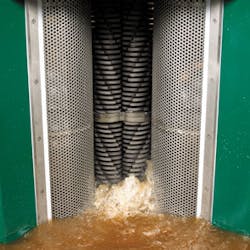Sewage Grinder Cuts Maintenance Costs, Protects Pumps at Santa Ana Lift Station
By Perla Lozano
In recent years, maintenance operators at the Segerstrom Lift Station, located in the city of Santa Ana, Calif., have noticed an escalation in pump ragging and blockages. This has led to an increase in maintenance expenses due to half- to full-day cleanings, along with an increase in man hours. As such, engineers sought the help of Costa-Mesa-based JWC Environmental, a wastewater treatment manufacturer, who recommended its Channel Monster sewage grinder as a viable solution.
The pump station, surrounded by quiet suburban homes, was built in the mid-1980s. Since then, the community and population have expanded. It now includes a high school, intermediate and elementary school and business park. Currently, the station runs on a quarterly inspection of the Gorman Rupp® pumps and check valves. The station is also supported by a backup alarm system in case of emergency.
When the Segerstrom Lift Station, located 35 miles south of Los Angeles, began filling with more and more polyester-
reinforced rags -- baby wipes, mop heads and cleaning wipes used at the surrounding schools and homes -- it became too much for the pumps to handle. This growing problem would clog the system every other day for 8 to 9 months, taking hours to clear the debris and fix the pumps. The city of Santa Ana needed a sewage grinder that would require low maintenance, protect its pumps upstream and fit its unique setting.
In addition, contributing to the unbudgeted expense in maintenance was the extraction of the system's rag
balls -- a process that required operators to break open the pump fittings in order to reach the problematic areas. "Every time the pumps would clog, we had to go in there. It's a confined space, so [it's] not easy," said Nabil Saba, P.E., acting water manager for the city. "Every time, we had to open the pumps and break the seals, and every time, the workers were exposed to raw sewage."
Moreover, a major challenge for city engineers was finding a waste grinder that would fit outside their lift station in an upstream manhole. The manhole had a diameter of 60 inches (1,524 mm) and was located underneath a busy street. After searching for the right grinder, Brian Ige, P.E. for the city of Santa Ana, discovered JWC's wastewater grinders and eventually consulted the company. He soon realized the company was located right around the corner from the pump station, and JWC offered a tour of the factory as well as a demonstration of its Muffin Monster® sewage grinders.
In October 2011, JWC installed a Channel Monster Model 2410 with a max flow of 3.7 million gallons per day (591 m3/h). The sewage grinder has a 5 HP (3.7 kw) immersible motor and now sits beneath a city street deep in a manhole to prevent pump ragging and other debris-clogging problems. The optimal place to position the sewage grinder was within a tight space in the nearest wet-well, located upstream of the lift station's system. Specializing in custom-fitted installations, JWC implemented the use of guide rails, which, in this case, created the best solution.
The manhole required these special guide rails and an easy access to maintain the sewage grinder. The sewage grinder was installed about 18 feet (5 meters) deep in front of the influent pipe. A stainless steel guide rail affixed to the wall of the wet-well (and lifting bail with chain) and attached to the modified frame would allow for easy aboveground access to the sewage grinder. No personnel are required to enter the manhole for inspection. The easy access relieved the risk of exposure to wastewater and ultimately makes inspections a no-hassle task.
The newly-installed system came with automated PLC monitoring and controls. Further, the auto-load sensing and reversing reduces any interruptions that the flow may bring. Likewise, the Channel Monster Model 2410 features a dual-shafted waste grinder capable of handling a wider variety of solids than a single-shafted machine. Counter-rotating shafts direct solids toward the center of the waste grinder, and three motor options allow precise control and independent operation of the drums and cutter stack.
One year later, city engineers report that the sewage grinder is operating well and has improved the quality of maintenance.
JWC Environmental is an exhibitor at WEFTEC.14 and can be found at Booth 4729. For more information, visit www.jwce.com.

